
Fits like a glove: the big child car seat guide
A child seat for your offspring is mandatory in Switzerland. Choosing the right model can prevent injuries or even save lives. I'll show you what you should look out for when buying one here.
At first glance, choosing a child car seat is all about following the rules and being able to carry your child in the car without having to pay a fine. At second glance, however, the real reason why you should take your time when buying a car seat becomes clear: the safety of your offspring. There are numerous models with various features such as a three-point harness system, Isofix connection or integrated 360-degree swivel. Read the following lines to find out what really counts.
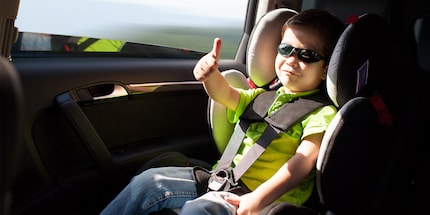
Regulation is regulation
According to Ordinance on Road Traffic Regulations (VRV) Art. 3a, 60, the use of a child restraint system is mandatory up to the age of 12 years or a height of 150 centimetres (whichever comes first). After that, seat belts must be worn. This applies not only to the front passenger seat, but also to the rear seat. Exceptions apply to seats with lap belts (also known as 2-point belts), journeys in company cars and in special child seats.
Only as many people may be carried in the car as there are seats available according to the vehicle licence. Children can be transported in either the front or rear passenger seat. The TCS recommends choosing the rear seat whenever possible. These and the above rules also apply in most European countries.
But why at all?
For adults, a seat belt, together with the airbags, is enough to protect the body from major injuries or worse. However, the situation is completely different for small children: Their bodies are not yet fully developed and the proportions are in a different relationship to each other.
A baby's head accounts for around a third of its body weight, compared to just a fortieth for an adult. This means that the head needs special protection. As does the pelvis, which is only fully ossified from the age of 12. The standard belt system could slip without a child seat and cause serious internal injuries.

Not a negligible risk
If you don't secure your child properly, a collision at 30 km/h can have fatal consequences. This speed is roughly equivalent to a fall from a height of 3.5 metres. Unrestrained children are just as much at risk in an accident situation as children who are not properly secured. So if you have a child seat, please make sure that it really is properly secured.
The right choice
There are three types of child seats. These can be approved according to the ECE R44 or ECE R129 standard. The R44 standard divides the seats into groups depending on how heavy the child is. Age specifications are to be understood as an additional indication. In contrast, the R129 standard, which has been in force since 2014, is based on height rather than weight. Incidentally, R129 seats must fulfil stricter requirements than R44 products.
In the R44 standard, Group 0+ ranges from 0 to 13 kilograms (or up to approx. 1.5 years). Group 1 ranges from 9 to 18 kilograms (or from 1 to 4 years) and Group 2/3 from 15 to 36 or more kilograms (or from 4.5 to 12 years). As mentioned, the R129 is selected according to body size. Manufacturers can specify the size range for which the seat is intended - therefore grouping is not possible here.
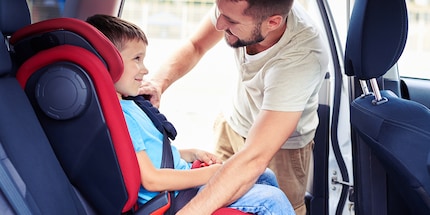
Not like this!
You've fitted the child seat, now nothing can happen to your child. Or so you think! In 2012, the bfu found out that although 93% of all children are carried in a seat, half of them are not secured correctly. If you don't install your seat properly, strap your child in incorrectly or carry them in the wrong direction, this can be just as dangerous as not securing them at all.
The biggest sources of error are attaching the child seat too loosely, twisting the straps (or they are also too loose), incorrect belt routing (e.g. along the neck) and placing a child who is too small or too big in the seat. In winter, the belts are often routed over the toddler's jacket - this is wrong. The jacket must either be removed or opened so that the straps lie directly against the body.
Isofix and you're done
The standard system for securing child seats enables quick and secure fastening, as the seat is connected directly to the car. This minimises operating errors and maximises safety. There are three different types of Isofix seats: Child seats with the standard system, those with an additional top tether (another, upper fastening strap) and those in which a support foot further increases safety.
Important: Not all Isofix child seats automatically fit in every car. There is a list for each seat that shows which vehicles fit it. You can also find the latest information on the car manufacturer's website. Incidentally, it has been mandatory to fit an Isofix mount in every new vehicle since 2014.
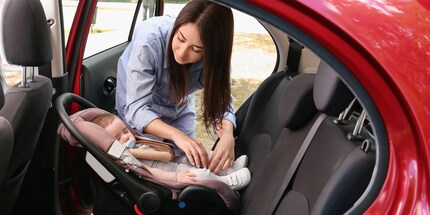
For the very little ones
If the little ones are still very small, they should be transported rear-facing. Up to the age of around 18 months, these seats offer the advantage that the head, spine and back are much better protected in the event of a collision. This minimises the risk of injury to your child considerably. Rear-facing infant car seats are very popular for very small children up to 13 kilograms. The following applies here: tighten the straps as well as possible and open or remove any jackets. If the infant car seat is not secured in the car with a base station, it is essential to ensure that the harness is correctly positioned.
The TCS test winners at Galaxus [[product:6571288,7327683,7946579]]
For the medium-sized ones
As soon as the child's head protrudes beyond the infant car seat, it is necessary to switch to the next larger seat variant. These child seats often use harnesses similar to racing harnesses, which you should regularly adjust to the size of your child. The seats may also be equipped with safety harnesses to provide additional protection for your child. Rear-facing models are also an option here. They offer the advantage of being safer, but also have the disadvantage that they require more space, making access to the child more difficult. As soon as your child's head protrudes over the seat, you will have to reach for the next larger model.
The TCS test winners at Galaxus [[product:7327425,8789519,7181836]]
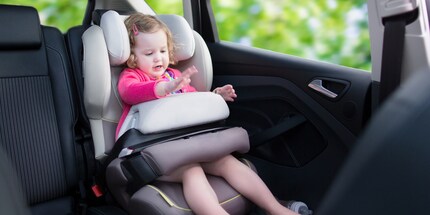
For the big ones
The next level of child seat is a booster seat with a backrest. These seats are suitable for children between the ages of around four and twelve, or up to a height of 150 centimetres. After that, the seat belt requirement also applies to adults. With this type of child seat, your child is protected in both frontal and side collisions. I would advise against booster seats without a backrest, as they are inexpensive and fulfil the legal requirements, but do not offer sufficient protection.
The TCS test winners at Galaxus [[product:6649677,6650271,6593232]]
Integrated, adaptive and growing with the child
Child seats that are already integrated into the vehicle by the manufacturer offer the advantage that they are always available in the vehicle and also fit perfectly. However, they are very often difficult to adapt to growing children. You can also no longer use them if you change vehicles.
Although belt adapters keep the belt away from the child's neck, they also change the belt guide in the pelvic and abdominal area. This can lead to serious internal injuries in the event of an accident. You should therefore make sure that adapters are ECE-certified. There are currently no such belt adapters approved in Switzerland.
Adjustable child seats can be used by children between the ages of one and twelve. They offer good value for money, as only one model needs to be purchased. However, the disadvantage is that installation is very time-consuming and additional belts are required. This often leads to operating errors. This is a poor compromise, as the child is protected at all times, but at no time as necessary. Seats with safety harnesses are an exception here.
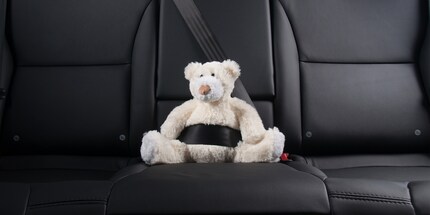
Would you like to continue benefiting from product guides and TCS test winners? I'd be happy for you to subscribe to my plan so you won't miss any more articles from me. <p
When I'm not stuffing my face with sweets, you'll catch me running around in the gym hall. I’m a passionate floorball player and coach. On rainy days, I tinker with my homebuilt PCs, robots or other gadgets. Music is always my trusted companion. I also enjoy tackling hilly terrain on my road bike and criss-crossing the country on my cross-country skis.